
Author Tom Iliffe leads scientists on a cave dive. Photo: Jill Heinerth
Maybe when you picture a university professor doing research it involves test tubes and beakers, or perhaps poring over musty manuscripts in a dimly lit library, or maybe going out into the field to examine new crop-growing techniques or animal-breeding methods. All of it’s good, solid research and I commend them all.
Then there is what I do – cave diving. To study the biology and ecology of coastal, saltwater caves and the marine fauna that inhabit them, my cave diving partners and I head underground and underwater to explore these unique and challenging ecosystems. Often we go to places no other human has been. While the peaks of the tallest mountains can be viewed from an airplane or the depths of the sea mapped with sonar, caves can only be explored firsthand.
Around the globe, from Australia to the Mediterranean, from Hawaii to the Bahamas and throughout the Caribbean, I have explored more than 1,500 such underwater caves over the last 40 years. The experience can be breathtaking. When you are down 60 to 100 feet in a cave that has zero light and is 20 miles long, you never know what you are about to see as you turn the next corner.
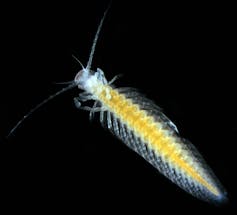
Tom Iliffe, CC BY-ND
My primary focus is searching for new forms of life – mostly white, eyeless crustaceans – that are specifically adapted to this totally dark, food-poor environment. Cave diving is an essential tool in our investigations since the caves I’m interested are filled with water: typically a layer of fresh or brackish water on the surface and then saltwater at depths of 10 to 20 meters or more.
There’s no other way to access these unexplored areas than to strap on your scuba tank and jump in.
Scientific research as extreme sport
The list of what can go wrong in a cave dive could fill your event planner.
Equipment or light failure, leaking scuba tanks, broken guide lines, getting lost, cave collapse, stirred up silt resulting in zero visibility, poisonous gas mixtures – you get the idea.
It’s fieldwork that can be a matter of life or death. I have had some close calls over the years, and sadly, have lost several good friends and researchers in cave accidents.
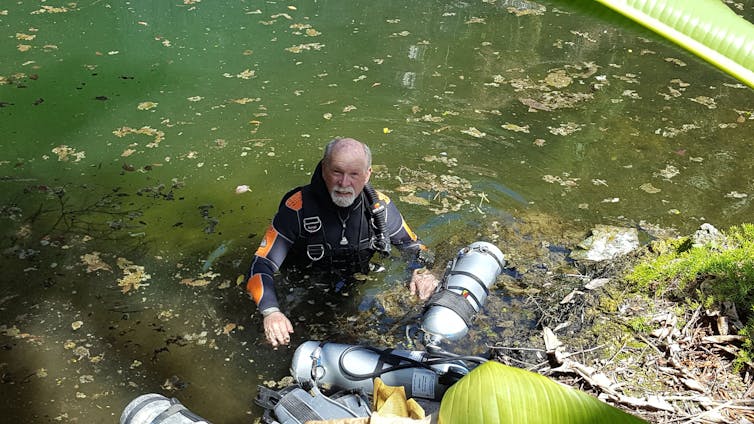
Gil Nolan, CC BY-ND
To put it mildly, underwater caves can be very hostile and unforgiving. One such cave – the Devil’s System in north-central Florida – has claimed at least 14 lives in the last 30 years, and there are other examples elsewhere in Florida and in Mexico.
Most of the time, human error is to blame, when divers don’t follow the rules they should or lack essential training and experience in cave diving.
My family has gotten used to the idea that what I do is not always a walk in the park. They know that since I’m 69, I stress safety, being physically and mentally prepared, and that I religiously abide by the cardinal rule of cave diving – that you never ever dive alone. My colleagues and I usually go into a cave with teams of two to three divers and constantly look after each other to see if there is anything going wrong during our dives, which usually last about 90 minutes, but can be as long as three hours or more.
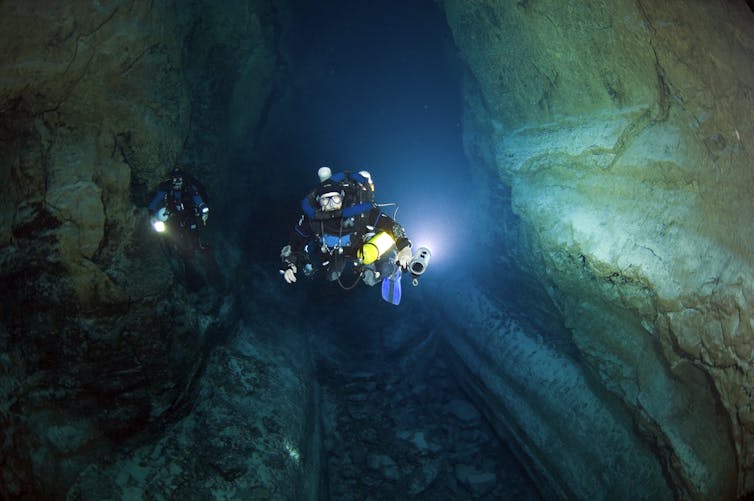
Jill Heinerth, CC BY-ND
Death-defying dives pay off in discoveries
It’s not just new species we are discovering, but also higher groups of animals including a new class, orders, families and genera, previously unknown from any other habitat on the planet. Some of our newfound animals have close relatives living in similar caves on opposite margins of the Atlantic Ocean or even the far side of the Earth (such as the Bahamas versus Western Australia).
While most of these caves are formed in limestone, they can also include seawater-flooded lava tubes created by volcanic eruptions. Amazingly, similar types of animals inhabit both.
In the deserts of West Texas, our team discovered and explored the deepest underwater cave in the U.S., reaching a depth of 462 feet.
The graduate students in my lab work on a diverse group of questions. They’re uncovering the nature of chemosynthetic processes in caves – how microorganisms use energy from chemical bonds, rather than light energy as in photosynthesis, to produce organic matter – and their significance to the cave food web.
Other students are examining records of Ice Age sea level history held in cave sediments, as well as the presence of tree roots penetrating into underwater caves and their importance to the overlying tropical forest. We’re finding evidence that sister species of cave animals on opposite shores of the Atlantic separated from one another about 110 million years ago as tectonic plate movements initiated the opening of the Atlantic, as well as determining how environmental and ecological factors affect the abundance and diversity of animals in saltwater caves.
Our research has significant implications, especially concerning endangered species and environmental protection. Since many cave animals occur only in a single cave and nowhere else on Earth, pollution or destruction of caves can result in species extinctions. Unfortunately, the creation of many protected areas and nature reserves failed to take cave species into account.
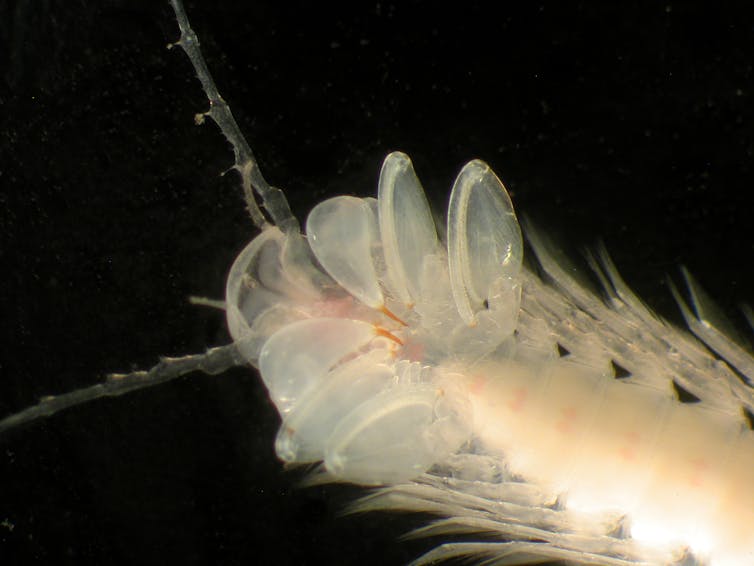
Tom Iliffe, CC BY-ND
Some discoveries can be completely unanticipated. For example, when we sequenced DNA from a variety of arthropods, including crustaceans and insects, the data strongly support a sister group relationship between hexapods (the insects) and remipedes, a small and enigmatic group of marine crustaceans exclusively found in underwater caves. This places the remipedes in a pivotal position to understanding the evolution of crustaceans and insects.
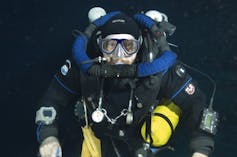
Jill Heinerth, CC BY-ND
Even at this stage of my life, to me the risks attendant to my cave diving research are worth it. It’s like the Star Trek mantra come true – to boldly go where no man has gone before. The chance to discover new forms of marine life, to view never-before-seen underwater formations, vast chambers, endless tunnels and deep chasms, to swim in some of the bluest and purest water on Earth – I will take that sort of research and its challenges any day.
![]() Yes, it can give new meaning to the old line about “publish or perish” in academia. But I love it, and I will tell you with all honesty, I can’t wait until my next trip.
Yes, it can give new meaning to the old line about “publish or perish” in academia. But I love it, and I will tell you with all honesty, I can’t wait until my next trip.
This article was originally published on The Conversation. Read the original article.

